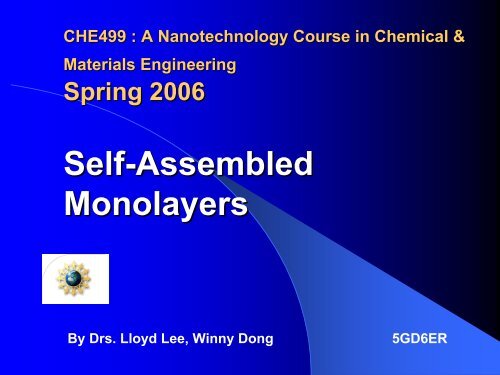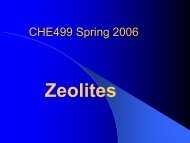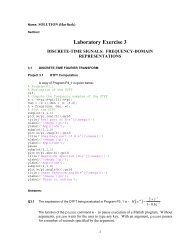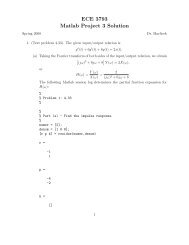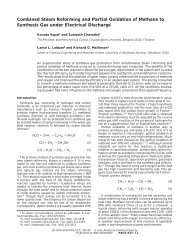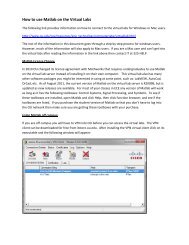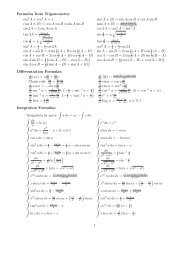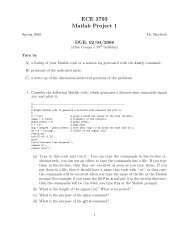Download self-assembled monolayers lecture
Download self-assembled monolayers lecture
Download self-assembled monolayers lecture
Create successful ePaper yourself
Turn your PDF publications into a flip-book with our unique Google optimized e-Paper software.
CHE499 : A Nanotechnology Course in Chemical &<br />
Materials Engineering<br />
Spring 2006<br />
Self-Assembled<br />
Monolayers<br />
By Drs. Lloyd Lee, Winny Dong 5GD6ER
Self-Assembled Monolayers<br />
(SAMs)
History<br />
• Nuzzo, R. G.; Allara, D. L. J. Am. Chem. Soc. 1983, 105, 4481.
Introduction<br />
• Self-<strong>assembled</strong> <strong>monolayers</strong> (SAMs) can be prepared using<br />
• alkylsiloxane <strong>monolayers</strong>,<br />
• fatty acids on oxidic materials and<br />
• alkanethiolate <strong>monolayers</strong>.<br />
O O<br />
• The principle is simple: A molecule which is essentially an<br />
alkane chain, typically with 10-20 methylene units, is given<br />
a head group with a strong preferential adsorption to the<br />
substrate used. Thiol (S-H) head groups and Au(111)<br />
substrates have been shown to work excellently. The thiol<br />
molecules adsorb readily from solution onto the gold,<br />
creating a dense monolayer with the tail group pointing<br />
outwards from the surface. By using thiol molecules with<br />
different tail groups, the resulting chemical surface<br />
functionality can be varied within wide limits. Alternatively,<br />
it is also possible to chemically functionalize the tail groups<br />
by performing reactions after assembly of the SAM.<br />
Book: Ultrathin Organic Films by A. Ulman, 2000.<br />
H 5 C 2 O<br />
O<br />
H2N<br />
Si<br />
O<br />
Si<br />
OH HO<br />
OH<br />
Si<br />
H 2 N<br />
Si<br />
O<br />
Si<br />
O<br />
O<br />
H 2 N<br />
Si<br />
O<br />
Si<br />
O<br />
O<br />
H 2 N<br />
H 2 N<br />
H 2 N<br />
HO<br />
HO<br />
Si OH<br />
Si O<br />
Si O<br />
O OH<br />
Si Si<br />
O
Applications:<br />
• Applications are molecular recognition, SAMs as<br />
model substrates and biomembrane mimetics in<br />
studies of biomolecules at surfaces, selective binding<br />
of enzymes to surfaces, chemical force microscopy,<br />
metallization of organic materials, corrosion<br />
protection, molecular crystal growth, alignment of<br />
liquid crystals, pH-sensing devices, patterned<br />
surfaces on the µm scale, electrically conducting<br />
molecular wires and photoresists.
Manufacture<br />
• The preferred crystal face for alkanethiolate<br />
SAM preparation on gold substrates is the<br />
(111) direction, which can be obtained either<br />
by using single crystal substrates or by<br />
evaporation of thin Au films on flat supports,<br />
typically glass or silicon. A schematic outline<br />
of the SAM preparation procedure on such<br />
gold substrates is given in the Figure,<br />
together with a schematic of a mixed SAM<br />
(see below). Several different solvents are<br />
usable at the low thiol concentrations<br />
(typically 1-2 mM). The most commonly<br />
used solvent is ethanol. Even though a <strong>self</strong><strong>assembled</strong><br />
monolayer forms very rapidly on<br />
the substrate, it is necessary to use<br />
adsorption times of 15 h or more to obtain<br />
well-ordered, defect-free SAMs. Multilayers<br />
do not form, and adsorption times of two to<br />
three days are optimal in forming highestquality<br />
<strong>monolayers</strong>.<br />
The substrate, Au on Si, is<br />
immersed in an ethanol solution of<br />
the desired thiol(s). Initial adsorption<br />
is fast (seconds); then an<br />
organization phase follows which<br />
should be allowed to continue for<br />
>15 h for best results. A schematic<br />
of a fully <strong>assembled</strong> SAM is shown<br />
to the right.
Tail Groups: Functionalization<br />
• As mentioned above, the tail<br />
group that provides the<br />
functionality of the SAM can be<br />
widely varied. CH3-terminated<br />
SAMs are commercially<br />
available; other functional<br />
groups can be synthesized by<br />
any well-equipped chemical<br />
laboratory, providing almost<br />
infinite possibilities of variation.<br />
In addition, chemical<br />
modification of the tail group is<br />
entirely possible after formation<br />
of the SAM, expanding the<br />
available range of functionalities<br />
even further.
SAM on AU (111) Surface<br />
A schematic model of the (sqrt(3)×sqrt(3))R30° overlayer structure formed<br />
by alkanethiolate SAMs on Au(111).
Characterization:<br />
• Among the most frequently used techniques are infrared spectroscopy,<br />
ellipsometry, studies of wetting by different liquids, x-ray photoelectron<br />
spectroscopy, electrochemistry, and scanning probe measurements. It has<br />
been clearly shown that SAMs with an alkane chain length of 12 or more<br />
methylene units form well-ordered and dense <strong>monolayers</strong> on Au(111)<br />
surfaces. The thiols are believed to attach primarily to the threefold hollow<br />
sites of the gold surface, losing the proton in the process and forming a<br />
(sqrt(3)×sqrt(3))R30° overlayer structure (shown in Figure ). The distance<br />
between pinning sites in this geometry is 5.0 Å, resulting in an available<br />
area for each molecule of 21.4 Å2. Since the van der Waals diameter of<br />
the alkane chain is somewhat too small (4.6 Å) for the chain to completely<br />
occupy that area, the chains will tilt, forming an angle of approximately 30°<br />
with the surface normal. Depending on chain length and chain-terminating<br />
group, various superlattice structures are superimposed on the<br />
(sqrt(3)×sqrt(3))R30° overlayer structure. The most commonly seen<br />
superlattice is the c(4×2) reconstruction, where the four alkanethiolate<br />
molecules of a unit cell display slightly different orientations when<br />
compared with each other.
• The Au-thiolate bond is strong - homolytic bond strength 44 kcal/mol<br />
- and contributes to the stability of the SAMs together with the van<br />
der Waals forces between adjacent methylene groups, which<br />
amount to 1.4-1.8 kcal/mol. The latter forces add up to significant<br />
strength for alkyl chains of 10-20 methylenes and play an important<br />
role in aligning the alkyl chains parallel to each other in a nearly alltrans<br />
configuration. At low temperatures, typically 100 K, the order is<br />
nearly perfect, but even at room temperature there are only few<br />
gauche defects, concentrated to the outermost alkyl units.<br />
One convenient method of checking a SAM for well-ordered and<br />
dense structure is infrared reflection-absorption spectroscopy<br />
(IRAS). The CH stretching vibrations of the alkyl chain are very<br />
sensitive to packing density and to the presence of gauche defects,<br />
which makes them ideally suited as probes to determine SAM<br />
quality. In particular, the antisymmetric CH2 stretching vibration (d-)<br />
at ~2918 cm-1 is a useful indicator; its position varies from 2916 or<br />
2917 cm-1 for SAMs of exceptional quality or cooled below room<br />
temperature, via 2918 cm-1 which is the normal value for a highquality<br />
SAM, to ~2926 cm-1 which is indicative of a heavily<br />
disordered, "spaghetti-like" SAM. A typical IRAS spectrum of the CH<br />
stretching region of a hexadecanethiolate (HS(CH2)15CH3 ) SAM is<br />
shown in the following Figure...
IRAS spectrum of a hexadecanethiolate SAM in the CH stretching<br />
region. The most prominent vibrations are indicated. d+ and d- are<br />
the symmetric and antisymmetric CH2 stretches; r+ and r- are the<br />
symmetric and antisymmetric CH3 stretches, respectively. At the<br />
measurement temperature (82 K), the ra- and rb-components of the r-<br />
peak are resolved.
• Thickness measurements using ellipsometry yield SAM<br />
thicknesses that are in good agreement with the 30° chain tilt<br />
mentioned above. For example, reported ellipsometric<br />
thicknesses of hexadecanethiolate SAMs lie in the 21±1 Å<br />
range, to compare with the 21.2 Å that result if a fully extended<br />
hexadecanethiol molecule of 24.5 Å length is tilted 30°.<br />
• Contact angle measurements further confirm that alkanethiolate<br />
SAMs are very dense and that the contacting liquid only<br />
interacts with the topmost chemical groups. Reported advancing<br />
contact angles with water range from 111° to 115° for<br />
hexadecanethiolate SAMs. At the other end of the wettability<br />
scale, there are hydrophilic <strong>monolayers</strong>, e.g., SAMs of 16-<br />
mercaptohexadecanol (HS(CH2)16OH), that display water<br />
contact angles of
Lithography
U Bielefeld
In Si(100), the anisotropic etch characteristic of a KOH was exploited for the<br />
fabrication of 35 nm wide and 30 nm deep grooves. The grating pattern was<br />
written in Octadecylthrichlorosilane (OTS) adsorbed onto hydroxilized Si(100).
DNA-Self<br />
Self-<strong>assembled</strong><br />
<strong>monolayers</strong>
DNA SAMs
Biotinylated SAMs (NIST)<br />
NIST
Mercury Removal:<br />
SAMs in Mesopores<br />
(Pacific NN Lab)
Mesoporous Silica for Mercury Removal<br />
• Xiangdong Feng, while a researcher for the Pacific Northwest<br />
National Laboratory, developed a process where molecules that<br />
can grab mercury out of the water are placed inside<br />
mesoporous silica. This spongelike rock has a surface area<br />
thousands of times larger than its size allowing it to grab the<br />
mercury quickly and efficiently. Eventually, Feng says, it should<br />
be possible to reduce the presence of mercury to a few parts per<br />
trillion, compared with a few parts per billion for current<br />
techniques, and do it more quickly as well. In addition, Feng<br />
says his invention can remove just about any pollutant or heavy<br />
metal from contaminated water. "People say I should quit my<br />
day job and start mining for gold."
Mercury Removal: SAM in<br />
Mesopores (Pacific NN Lab)<br />
• Under this task, a proprietary new technology, Self-Assembled Monolayers on<br />
Mesoporous Supports (SAMMS), for RCRA metal ion removal from aqueous<br />
wastewater and mercury removal from organic wastes such as vacuum pump oils is<br />
being developed at Pacific Northwest National Laboratory (PNNL).<br />
• The six key features of the SAMMS technology are 1) large surface area (>900 m2/g)<br />
of the mesoporous oxides (SiO2, ZrO2, TiO2) ensures high capacity for metal<br />
loading (more than 1 g Hg/g SAMMS); 2) molecular recognition of the interfacial<br />
functional groups ensures the high affinity and selectivity for heavy metals without<br />
interference from other abundant cations (such as calcium and iron) in wastewater;<br />
3) suitability for removal of mercury from both aqueous wastes and organic wastes;<br />
4) the Hg-laden SAMMS not only pass TCLP tests, but also have good long-term<br />
durability as a waste form because the covalent binding between mercury and<br />
SAMMS has good resistance to ion exchange, oxidation, and hydrolysis; 5) the<br />
uniform and small pore size (2 to 40 nm) of the mesoporous silica prevents bacteria<br />
(>2000 nm) from solubilizing the bound mercury; and 6) SAMMS can also be used<br />
for RCRA metal removal from gaseous mercury waste, sludge, sediment, and soil.<br />
Resource Conservation and Recovery Act (RCRA)
Hg-removal by SAM in Silica<br />
(SiO2, ZrO2, TiO2)
• Molecular <strong>self</strong>-assembly is a unique phenomenon in which functional<br />
molecules aggregate on an active surface, resulting in an organized<br />
assembly having both order and orientation.9-11 In this approach,<br />
bifunctional molecules containing a hydrophilic head group and a<br />
hydrophobic tail group adsorb onto a substrate or an interface as<br />
closely packed <strong>monolayers</strong>. The driving forces for the <strong>self</strong>-assembly<br />
are the inter- and intra-molecular interactions between the functional<br />
molecules (such as van der Waals forces). The tail group and the head<br />
group can be chemically modified to contain certain functional groups<br />
to promote covalent bonding between the functional organic molecules<br />
and the substrate on one end, and molecular bonding between the<br />
organic molecules and the metals on the other.9 By populating the<br />
outer interface with specific functional groups, an effective means for<br />
scavenging heavy metals is made available. The metal-loading<br />
capability is determined by the available surface area of the underlying<br />
inorganic support. A high surface area support allows for high RCRA<br />
metal loading.
High-Surface<br />
Mesoporous Supports<br />
• The unique mesoporous oxide supports provide high surface area<br />
(>900 m2/g), thereby enhancing the metal loading capacity. They also<br />
provide an extremely narrow pore size distribution, which can be<br />
specifically tailored from 15 Å to 400 Å, thereby minimizing<br />
biodegradation from microbes and bacteria. Mesoporous structures can<br />
be disposed of as stable waste forms.<br />
The porous supporting materials used in this research (SiO2, ZrO2,<br />
TiO2) are synthesized through a co-assembly process using oxide<br />
precursors and surfactant molecules.12-15 The material synthesis is<br />
accomplished by mixing surfactants and oxide precursors in a solvent<br />
and reacting the solution under mild hydrothermal conditions. The<br />
surfactant molecules form ordered liquid crystalline structures, such as<br />
hexagonally ordered rod-like micelles, and the oxide materials<br />
precipitate on the micellar surfaces to replicate the organic templates<br />
formed by the rod-like micelles. Subsequent calcination to 500°C<br />
removes the surfactant templates and leave a high surface area oxide<br />
skeleton. The pore size of the mesoporous materials is then<br />
determined by the rod-like micelles, which are extremely uniform. Using<br />
different chain length surfactants produces mesoporous materials with<br />
different pore sizes.


